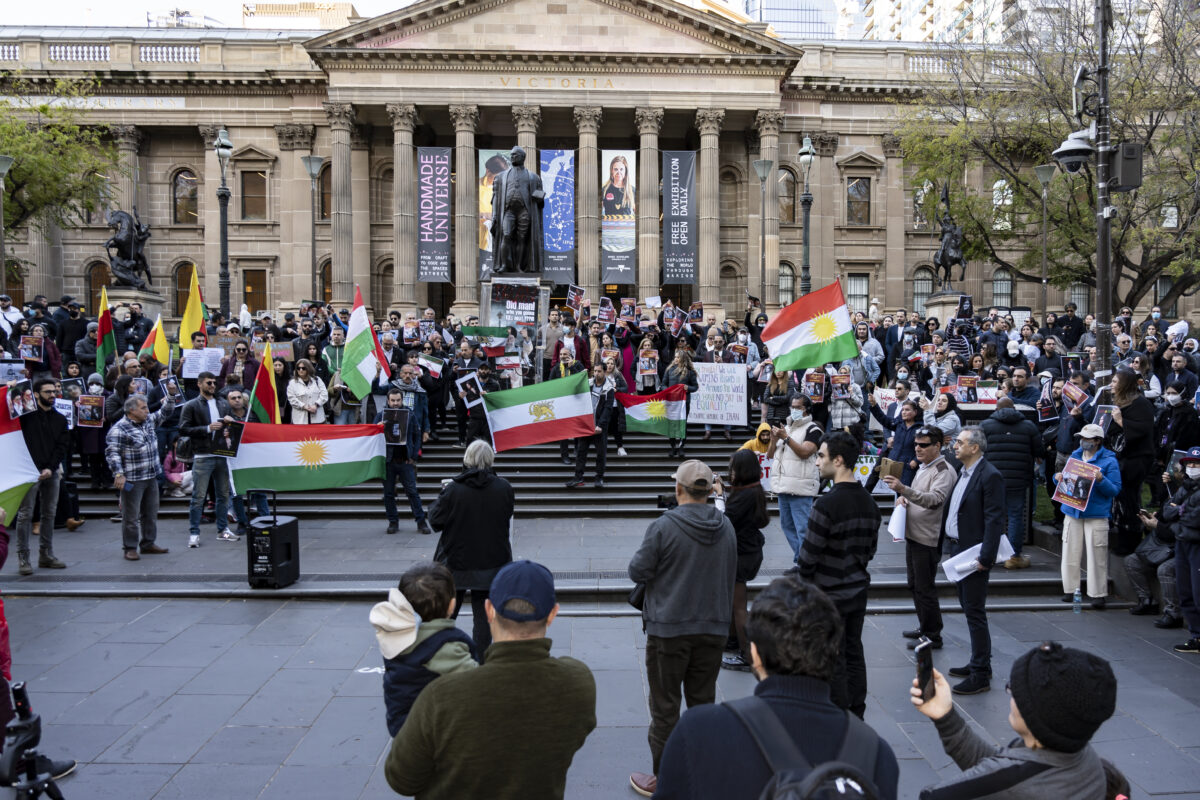Canberra is among the more than 150 cities across the world that have protested in support of women’s freedoms and Iranian human rights since the death of Mahsa Amini in the custody of Iran’s morality police on 16 September. In the face of a stubborn regime and its relentless oppression, the continuation of international action is vital to the success of the building revolution.
The Iranian morality police arrested Iranian Kurd Mahsa Amini for allegedly inappropriate attire. Amini died three days later while detained, allegedly from police beatings. This sparked anti-government protests in Kurdistan, which quickly spread to Tehran and a further 350 locations across Iran. With calls for “Women, life, liberty”, Iranian women and their international diaspora have removed and burnt their head coverings and cut their hair, calling for greater freedom, rights and recognition.
ANU lecturer in Iranian Studies,Dr Alam Saleh, noted that although the movement has been crucially female-led, it represents a broader agitation for democracy and an end to the oppression that has dominated Iranian lives since the 1979 revolution when the Islamic clergy claimed power.
Despite harsh crackdowns from the regime, large scale rioting has intensified in the past month. Although mostly women started the protests, Iranians of all demographics are now taking to the streets, clashing with police, striking, and encouraging the withholding of taxes. It is estimated that over 200 civilians and 20 members of state forces have been killed because of these political clashes, as of 13 October.
The attention of Western media and the international spread of solidarity protests, Saleh details, “encourages people inside Iran that they are not neglected or ignored by the world, the world is watching and it cares. Issues in Iran matter to them as well.”
He explains the international momentum of this uprising as a product of the age of information. With mass communication and social media carrying events across the world as they happen, this popular unrest is “not just an Iranian issue, but a women’s issue and a human rights issue.” Saleh argues it concerns “every human being that cares about the brutal confrontation of the regime against the youth and women in Iran.”
Supreme Leader Ayatollah Ali Khamenei has not acknowledged the protests as anything more than “scattered riots” and has remained unresponsive to citizen’s demands and international concern.
This neglect has been compounded by threats and accusations, reducing protestors as making a “mistake” that might be corrected through punishment. The regime has also blamed foreigners for the internal failures of the regime – both economic and social.
Continued international pressure not only encourages and supports those protesting on the streets of Iran’s cities but urges foreign governments to take diplomatic action against the regime.
ANU student, Paria Najafzadeh, highlighted the significant role of the Iranian diaspora in the protests thus far. “In each country they are the leaders of these protests… I think the diasporic population really differ in demographic, but a lot of people left around the Islamic Revolution or after, so they have the experience and have struggled under the Islamic regime.”
Their action “doesn’t just come from general concern… while it’s great to see others care and protest, they wouldn’t be able to mobilise week after week.” While Western support is important, Najafzadegh noted that “it’s important for people to know that this oppressive regime is the result of Western intervention in Iran from the last century, and so moving forward… this has to be a process of Iranian revolution.”
Najafzadeh outlined the mixed emotions felt in the immediate wake of the initial unrest. She talked of a tenuous balance of hope and fear that she’d shared with other Iranian students and noted that “the first images getting spread around social media [were] quite inspiring…but confronting as well, because all of my family live in Iran. While I see images of protests in the street, that’s their reality.”
Saleh emphasises that although the women’s rights movement in Iran is “not something new”, with an increased consciousness of rights, women and youth activists have “reached the point to demand their rights on their own without being led by any other forces.”
This is an Iranian movement, but as students across the world who don’t face serious harm when protesting, Najafzadeh urges those at ANU to not close their eyes to the cause. This includes watching out for protests (such as those held in recent weeks at Old Parliament House and the Iranian Embassy), staying informed from accurate news sources, and supporting any friends who might be affected.
Despite the fragility of the hope brought about by the movement, as Najafzadeh notes, there is promise in “the longer it goes on” because “the revolution isn’t getting quashed.” Najafzadeh pointed out that “…the most dangerous part of revolution is to let it fade.”
We acknowledge the Ngunnawal and Ngambri people, who are the Traditional Custodians of the land on which Woroni, Woroni Radio and Woroni TV are created, edited, published, printed and distributed. We pay our respects to Elders past and present. We acknowledge that the name Woroni was taken from the Wadi Wadi Nation without permission, and we are striving to do better for future reconciliation.
